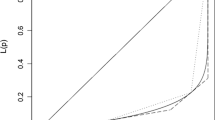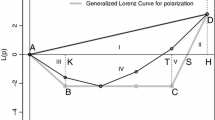Abstract
We provide a new way of interpreting the Gini correlation in the income source decomposition of the Gini index as a linear function of the ratio of the concordance pseudo-Gini (which measures the degree of agreement between the ranking of the incomes within a particular source and the ranking with respect to total income) to the within-source Gini (which measures income disparities within a particular income source). As a by-product, we discuss the modifications of the stochastic approach to the Gini index to take survey weights into account. We also discuss the income source decomposition of the Gini index when the incomes are weighted.
Similar content being viewed by others
References
Berger, Y.G.: A note on the asymptotic equivalence of jackknife and linearization variance estimation for the Gini coefficient. J. Official Stat. 24, 541–555 (2008)
Creedy, J.: A note on computing the Gini inequality measure with weighted data (Victoria University of Wellington Working Papers in Public Finance No: 03/2015). Retrieved from https://ideas.repec.org/p/vuw/vuwcpf/4235.html. Accessed 16 Aug 2015
Fei, J.C.H., Ranis, G., Kuo, S.W.Y.: Growth and the family distribution of income by factor components. Q. J. Econ. 92, 17–53 (1978)
Langel, M., Tillé, Y.: Variance estimation of the Gini index: revisiting a result several times published. J. R. Stat. Soc. Ser. A. 176, 521–540 (2013)
Lerman, R.I., Yitzhaki, S.: A note on the calculation and interpretation of the Gini index. Econ. Lett. 15, 363–368 (1984)
Lerman, R.I., Yitzhaki, S.: Income inequality effects by income source: a new approach and applications to the United States. Rev. Econ. Stat. 67, 151–156 (1985)
Lerman, R.I., Yitzhaki, S.: Improving the accuracy of estimates of the Gini coefficients. J. Economet. 42, 43–47 (1989)
Ma, C., Wang, X.: Application of the Gini correlation coefficient to infer regulatory relationships in transcriptome analysis. Plant Physiol. 160, 192–203 (2012)
Ogwang, T.: Additional properties of a linear Pen’s parade for individual data using the stochastic approach to the Gini index. Econ. Lett. 96, 369–374 (2007)
Ogwang, T.: A convenient method of decomposing the Gini index by population subgroups. J. Official Stat. 30, 91–105 (2014)
Schechtman, E., Yitzhaki, S.: A measure of association based on Gini’s mean difference. Commun. Stat. Theory Meth. 16, 207–231 (1987)
Schechtman, E., Yitzhaki, S.: On the proper bounds of Gini correlation. Econ. Lett. 63, 133–138 (1999)
Shalit, H.: Calculating the Gini index of inequality for individual data. Oxford Bull. Econ. Stat. 47, 185–189 (1985)
Shih, W.J., Huang, W.M.: Evaluating correlation with proper bounds. Biometrica 48, 1207–1213 (1992)
Shorrocks, A.F.: Inequality decomposition by factor components. Econometrica 50, 193–211 (1982)
Stark, O., Taylor, J.E., Yitzhaki, S.: Remittances and inequality. Econ J. 96, 722–740 (1986)
Author information
Authors and Affiliations
Corresponding author
Appendix: Proof that re-scaling the weights has no effect of the estimated Gini index
Appendix: Proof that re-scaling the weights has no effect of the estimated Gini index
Consider the expression for the Gini index as given by Eq. (2) in this paper.
Let \(\hat{G}(w)\) denote the overall Gini index when the weight assigned to \(y_{i.} \) is \(w_i \),\(i=1,2,\ldots ,n\). Also let \(\bar{{r}_{i.}} ^ {*} (w)=2\bar{r}_{i.} (w)-\left( {\sum \nolimits _{j=1}^n {w_j } }\right) -1\) be the transformed average rank vector when the weight assigned to \(y_{i.} \) is \(w_i \), \(i=1,2,\ldots ,n\), where \(\bar{r}_{1.} (w)=\left( {\frac{w_1 +1}{2}}\right) \); \(\bar{r}_{2.} (w)=w_1 +\left( {\frac{w_2 +1}{2}}\right) \); \(\bar{r}_{3.} (w)=w_1 +w_2 +\left( {\frac{w_3 +1}{2}}\right) \); \(\bar{r}_{4.} (w)=w_1 +w_2 +w_3 +\left( {\frac{w_4 +1}{2}}\right) \); etc.
Let \(\hat{G}(aw)\) denote the overall Gini index when the weight assigned to \(y_{i.} \) is \(\left( {aw_i }\right) \), \(i=1,2,\ldots ,n\), where a is a suitable positive constant which is used to re-scale the weights. Also let \(\bar{{r}_{i.}} ^ {*} (aw)=2\bar{r}_{i.} (aw)-\left( {\sum \nolimits _{j=1}^n {aw_j } }\right) -1\) be the transformed average rank vector when the weight assigned to \(y_{i.} \) is \(aw_i \), \(i=1,2,\ldots ,n\), where \(\bar{r}_{1.} (aw)=\left( {\frac{aw_1 +1}{2}}\right) \); \(\bar{r}_{2.} (aw)=aw_1 +\left( {\frac{aw_2 +1}{2}}\right) \); \(\bar{r}_{3.} (aw)=aw_1 +aw_2 +\left( {\frac{aw_3 +1}{2}}\right) \); \(\bar{r}_{4.} (aw)=aw_1 +aw_2 +aw_3 +\left( {\frac{aw_4 +1}{2}}\right) \); etc.
It is easy to verify that \(\bar{{r}_{i.}} ^ {*} (aw)=a\bar{{r}_{i.}} ^ {*} (w)\), \(i=1,2,\ldots ,n\).
Hence, it follows from Eq. (2) that \(\hat{G}(aw)=\left( {\frac{1}{\sum \nolimits _{j=1}^n {aw_j } }}\right) \frac{\sum \nolimits _{i=1}^n {\bar{{r}_{i.}} ^ {*} (aw)aw_i y_{i.} } }{\sum \nolimits _{i=1}^n {aw_i y_{i.} } }=\left( {\frac{1}{\sum \nolimits _{j=1}^n {aw_j } }}\right) \frac{\sum \nolimits _{i=1}^n {a\bar{{r}_{i.}} ^ {*} (w)aw_i y_{i.} } }{\sum \nolimits _{i=1}^n {aw_i y_{i.} } }=\left( {\frac{1}{\sum \nolimits _{j=1}^n {w_j } }}\right) \frac{\sum \nolimits _{i=1}^n {\bar{{r}_{i.}}^ {*} (w)w_i y_{i.} } }{\sum \nolimits _{i=1}^n {w_i y_{i.} } } =\hat{G}\left( w\right) \)
This completes the proof.
Rights and permissions
About this article
Cite this article
Ogwang, T. A new interpretation of the Gini correlation. METRON 74, 11–20 (2016). https://doi.org/10.1007/s40300-015-0076-1
Received:
Accepted:
Published:
Issue Date:
DOI: https://doi.org/10.1007/s40300-015-0076-1




